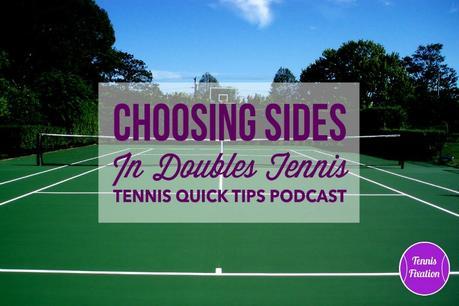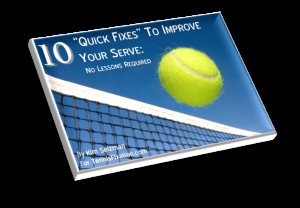Podcast: Play in new window | Download
Which side should you return from when playing doubles? The deuce court side? The ad court side? How do you and your partner decide who takes which side? In this episode of Tennis Quick Tips, we'll discuss five factors to consider when choosing which side to return from in doubles. You can listen to this episode by clicking on the media player above or by listening in with your favorite podcast app. You can also subscribe in iTunes by clicking on this link: tennisfixation.com/itunes.

SHOW NOTES:
This week, we're talking about how to decide which side you should return from when playing doubles. And I'm not talking about whether you should return from the sunny side, or the windy side, or the side that is completely in the shade. Rather, we're talking about how a team of doubles partners should decide which partner will return from the deuce side and which partner will return from the ad side.
I play on three tennis teams right now and that means I play with a lot of different tennis partners. A lot. And, in my opinion, most people take this decision very lightly. Which is fine if you really don't have a preference for which side you play on. But I have recently decided to be a little more involved in this decision, to give it more consideration, and to make clear to my partner that I really do have a preference as to sides.
So what factors should you consider when deciding whether to play the deuce side or the ad side in your doubles matches?
1. What is Your (or Your Partner's) Personal Preference on Sides?
The first thing I think you should consider is personal preference. Does one partner have a strong personal preference for playing one side or the other? While I have found that most people don't seem to care too much, there are some players who are very insistent about playing one side or the other. For whatever reason. They may not indicate why. They just make it clear that they must play on a particular side. They may even go to the captain and say, "I just want to play the ad side." And it does seem that there are many people, who if they have a strong preference, it's for the ad side.
So the first thing to consider when choosing sides is, does someone have a strong personal preference for one side or the other? If so, you might want to defer to that. You might want to let that be the way you decide who plays which side.
Having said that, that is not the only thing you can look at in this situation. In fact, even if someone does have a strong personal preference, there might be other things to take into consideration. And this is where my position, as far as what I now tell my partners and what I choose to do, has changed. So what are these other factors to consider?
2. Does One Partner Have a Great Shot to Take Advantage of on One Side or the Other?
The second thing I would look to is, does someone have a great shot to take advantage of? A shot that really only works if they're returning from one side of the court or the other. This actually just happened to me on Monday of this week. I played with a partner who really wanted the forehand side. She was very insistent on that. And of course, the forehand side is the deuce side. And it was because she had a great forehand return. I mean really good. That forehand return was so good that it was definitely worth her being on that side of the court. So she played the deuce side, I took the ad side, and it worked out great and we won the match. And I do believe her return had a lot to do with that.
So the second factor to consider, does someone have a really great shot that they can take advantage of on one side of the court or the other?
3. Is One Partner a Great Poacher and How Can You Set That Up?
Number 3, I would look at poaching. Is someone really good at poaching? Is one of the partners particularly aggressive up at the net? Does one of the partners have a better forehand or backhand volley and you want to put them into position to use it to poach? And, similarly, is there a way to set up a combo where one of the partners is hitting a great return that leaves the other partner open to poach. Again, this happened to me recently. I was actually playing the deuce side and I have a good return where I can hit a very wide return, a return that actually bounces in the alley and that almost always can set my partner up for a good poach or it means that my opponent is going to hit a bad shot in response. Either they're going to hit a shot that my partner can poach or they're going to hit a shot that, by attempting to avoid my poaching partner, is a bad shot.
So that Number 3 thing to look into is, is one of the partners a better poacher or a more aggressive net player and where does that partner want to be positioned so that their better volley is up at the net and they're in position with that.
4. Who Can Cover the Down-The-Line Return Better?
Number 4, I would look at down-the-line returns. Is one of the partner's volleys better at protecting against those down-the-line returns. And this may be something that you think about because you know your opponents and you know whether or not they're very likely to hit down-the-line returns. Or you're playing a more advanced level of tennis where down-the-line returns can be expected. I think, at lower levels, this might not be the kind of thing that impacts the decision as to who's going to return from the deuce court and who's going to return from the ad court because at lower levels you're going to see a lot more cross-court returns and keeping it towards the middle.
5. Who Can Cover the Backhand Lob Better?
Finally, another factor I would look at is lob coverage. If you think about two rightie partners playing together, the person who is in the deuce court, if a ball is lobbed over their partner's head, then that person is very likely to be taking that initial lob, depending on how high it goes or how deep it is, with their backhand. So, is it better for one partner or the other to take that lob with a backhand? A lot of balls in doubles are going to come to the middle of the court so who is better to have with their backhand in the middle if both players are righties?
What I'll Be Doing with my Partners Going Forward
Now, I said right up front that I've changed my position on this. Initially, I was very willing to let whoever my partner was make the decision as to whether they would return from the deuce court or the ad court and then I would just take whatever was left. In the last few weeks, I've really come to feel that I like playing the ad court. I like being the backhand player. I think, for a number of reasons, that's true and I've decided that, going forward, I am going to be a little more forceful in making that choice when I'm matched up with partners. Particularly, if I continue to get partners, as I do and as I'm sure a lot of us do, that say, "Oh, it's OK with me, whatever side, I don't care." I'm going to be the one to say, "Well in that case, I'll take the backhand side or I'll take the ad court side and let's see what happens."
But there are a lot of factors to look at so when you get out there, be thinking about those things I've listed. It's not a decision to take real lightly, but once you get underway, there's a lot of switching around so it's not the end of the world if you feel like you made the wrong choice to start your match. And you can always switch it up in the second set if you want to change your positioning.
SHARE, SUBSCRIBE AND REVIEW:
Thanks so much for being a listener and friend of the Tennis Quick Tips podcast. And I hope you'll consider sharing this podcast with your friends and leaving a review of the show as it really helps it to be found by other like-minded tennis players. You can listen in, subscribe or leave a review by going to:
GET A BETTER SERVE FAST!
And if you're interested in getting a better serve - fast! - get my free ebook, 10 Quick Fixes to Improve Your Serve: No Lessons Required.

By applying the 10 simple tips to your serve that I give in this ebook, your serve can become a tool that you can use to gain control of points. It can become more powerful, more accurate, and something you're actually proud of. Just enter your email below and you'll get instant access to this free ebook as well as weekly updates with all of my best tennis tips!

© Kim Selzman 2015 All Rights Reserved

